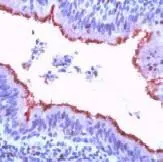beta Tubulin antibody [DM1B]
GTX27287
ApplicationsImmunoFluorescence, Western Blot, ImmunoCytoChemistry
Product group Antibodies
TargetTUBB
Overview
- SupplierGeneTex
- Product Namebeta Tubulin antibody [DM1B]
- Delivery Days Customer9
- Application Supplier NoteFor IF: Use at a concentration of 4 - 6 microg/ m l. For WB: Use at a concentration of 4 -6microg/ m l. Detects a band of approximately 60 kDa. Optimal dilutions/concentrations should be determined by the researcher.
- ApplicationsImmunoFluorescence, Western Blot, ImmunoCytoChemistry
- CertificationResearch Use Only
- ClonalityMonoclonal
- Clone IDDM1B
- Concentration0.2 mg/ml
- ConjugateUnconjugated
- Gene ID203068
- Target nameTUBB
- Target descriptiontubulin beta class I
- Target synonymsCDCBM6, CSCSC1, M40, OK/SW-cl.56, TUBB1, TUBB5, tubulin beta chain, beta Ib tubulin, epididymis secretory sperm binding protein, tubulin beta-1 chain, tubulin beta-5 chain, tubulin, beta polypeptide
- HostMouse
- IsotypeIgG1
- Scientific DescriptionCytoskeletal proteins are found in highly organized arrays within the cytoplasm of higher eukaryotic cells. These proteins are intimately involved in functions such as cell and intracellular organelle movement, maintenance of cell shape and endocytosis. The cytoskeleton of most eukaryotic cells is comprised of at least three fibrous systems each with accessory proteins: the microfilaments, composed of actin; the microfibrils, composed of tubulin; and the intermediate filaments composed of vimentin. Monoclonal antibodies have been used to study the components of the cytoskeleton and their intracellular location, changes in the expression of these elements during differentiation, and the function of the cytoskeleton in living cells by microinjection of the antibodies.
- Storage Instruction2°C to 8°C
- UNSPSC12352203
References
- CD40 is a regulator for vascular endothelial growth factor in the tumor microenvironment of glioma. Xie F et al., 2010 May, J NeuroimmunolRead more


![ICC/IF analysis of 3T3 cells using GTX27792 beta Tubulin antibody [TU-06]. Green : Primary antibody Blue : DAPI](https://www.genetex.com/upload/website/prouct_img/normal/GTX27792/GTX27792_20191025_AP_002_196_w_23060722_713.webp)
![ICC/IF analysis of SH-SY-5Y cells using GTX11307 beta Tubulin antibody [D66] at 0.5 microg/mL(red) with DAPI (blue). Cells were fixed and permeabilized with methanol followed by methanol:acetone.](https://www.genetex.com/upload/website/prouct_img/normal/GTX11307/GTX11307_20170605_ICCIF_w_23060500_266.webp)
![WB analysis of chicken fibroblasts extract using GTX11311 beta Tubulin antibody [2-28-33]. Lane A : Antibody dilution 1:200 Lane B : Negative control (only secondary antibody)](https://www.genetex.com/upload/website/prouct_img/normal/GTX11311/GTX11311_20170605_WB_w_23060500_274.webp)
![ICC/IF analysis of HeLa cells using GTX11312 beta Tubulin I antibody [SAP.4G5] at 1:5000 (green) with DAPI(blue).Cells were fixed and permeabilized with 4% PFA followed by 0.5% Triton X-100.](https://www.genetex.com/upload/website/prouct_img/normal/GTX11312/GTX11312_20170605_ICCIF_w_23060500_752.webp)